Hi XuanLe,
Welcome to the Support Communities! The resources below will help you troubleshoot the issue you are having of No Service (cellular data) and syncing with iTunes 7 on your PC.
If you see No Service in the status bar of your iPhone or iPad - Apple Support
http://support.apple.com/en-us/TS4429
Follow these steps, testing after each.
- Tap Settings > Enable Airplane Mode, wait five seconds, then turn off airplane mode.
- Restart your device.
- Remove the SIM card. If the SIM card is damaged, worn, or bent, or if it's too big or small for the SIM tray, contact your carrier for a new one. Then reinsert the SIM card.
- Check for a carrier-settings update: Connect to a Wi-Fi network, tap Settings > General > About, and install any available carrier-settings updates. If you can't connect to Wi-Fi, connect your device to a computer that has iTunes.
- Update your iPhone to the latest version of iOS.
- Reset network settings by tapping Settings > General > Reset > Reset Network Settings. This will reset all network settings, including Bluetooth pairing records, Wi-Fi passwords, VPN, and APN settings.
- Contact your carrier to check for any network or account issues.
- Restore your iPhone.
You might be outside of your carrier's coverage area. If you're traveling internationally, you'll need an international roaming plan to use your iPhone or iPad.
iPhone, iPad, or iPod touch not recognized in iTunes for Windows - Apple Support
http://support.apple.com/en-us/TS1538
Click on the link above to see the complete article. I've hightighted the information pertinent to Windows 7 for you.
Turn off your computer and your iOS device, then turn them on again.
Check to make sure that you've installed all required updates for your computer.
If you connect your iOS device to your computer and see "If you have not connected your iOS device to this computer before, unlock the device and tap Trust," make sure that your device trusts the computer.
Verify that the 30-pin to USB cable or Lightning Connector to USB cable is free of debris and not damaged. If another cable is available, test with that cable instead.
USB cables that are bundled with third-party products or accessories might work only to charge those products and might not transmit data. Also, if you're using a third-party case or extended battery pack, try removing the case and connecting the Apple-supplied USB cable directly to your device.
iOS devices require Apple Mobile Device Support, which should be automatically installed with iTunes. To verify whether it is installed, follow the steps appropriate for your Windows operating system below.
- Click Start.
- Choose Control Panel.
- Click "Uninstall a program" (or, if you're using Windows Vista's Classic View of the Control Panel, click "Programs and Features").
- Verify that Apple Mobile Device Support is visible in the list of currently installed programs.
- Connect the device to the computer.
- Quit iTunes if it launches.
- For Windows Vista and Windows 7:
- Click the Start menu, right-click on Computer, and choose Properties.
- In the upper-left corner, click Device Manager. The Device Manager window should open.
- Click the plus (+) icon (or disclosure triangle (
 ) (for Windows 7 and Windows 8) next to "Universal Serial Bus controllers" to expand this selection.
) (for Windows 7 and Windows 8) next to "Universal Serial Bus controllers" to expand this selection.
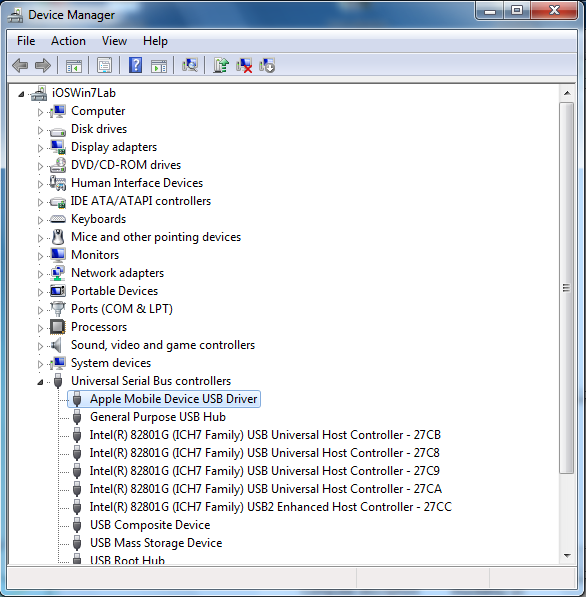
- Locate the Apple Mobile Device USB Driver in this list. If this entry is displayed without any downward arrow, "!" or "?" symbols over it, then this driver is successfully installed. Continue to "Check for third-party software conflicts".
- If the Apple Mobile Device USB Driver is not listed, continue to "If the Apple Mobile Device USB Driver is not listed".
- A downward arrow appearing next to the device's entry in Device Manager indicates that this device is disabled. To enable this device, right-click its entry in Device Manager and choose Enable from the shortcut menu.
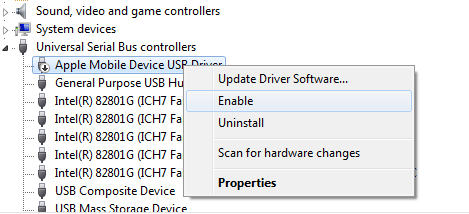
- If the Apple Mobile Device USB Driver entry is listed, but has an exclamation mark or question mark over it, reinstall the Apple Mobile Device driver:
- Right-click the Apple Mobile Device entry in Device Manager.
- Choose Uninstall from the shortcut menu.
- When prompted, select the box "Delete the driver software for this device," and click OK.
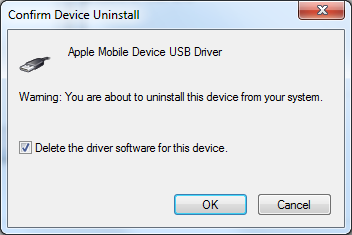
- In the resulting dialog box, click OK.
- In the Device Manager window, right-click "Universal Serial Bus controllers" and choose "Scan for hardware changes" from the shortcut menu.
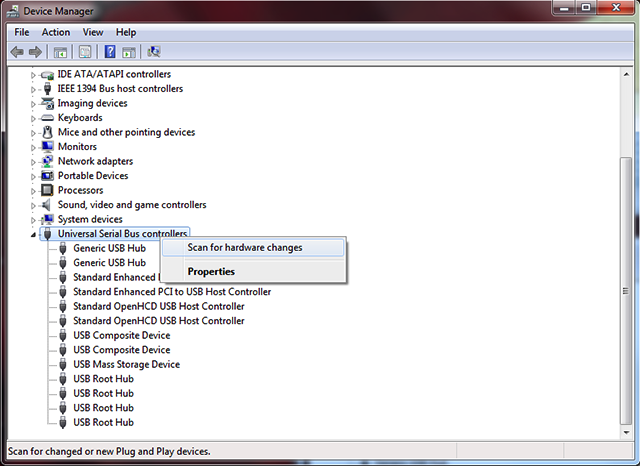
Windows automatically reinstalls the necessary drivers and attempts to remount the device.
- If the Apple Mobile Device USB Driver entry still has an exclamation mark or question mark over it, right-click this entry and choose Properties. Under the General tab, look beneath "Device status."
- If you see a message that reads: "Windows cannot verify the digital signature for the drivers required for this device. A recent hardware or software change might have installed a file that is signed incorrectly or damaged, or that might be malicious software from an unknown source. (Code 52)," see the section below for Error Code 52.
- If you see a different error code, manually update the Apple Mobile Device driver:
- Right-click the Apple Mobile Device entry in Device Manager.
- Choose Update Driver Software.
- Select "Browse my computer for driver software."
- Select "Let me pick from a list of device drivers on my computer."

- Click the Have Disk button. If the Have Disk option is not available, choose a device category such as Mobile Phone or Storage Device (if listed). Then click next. The Have Disk button should appear.
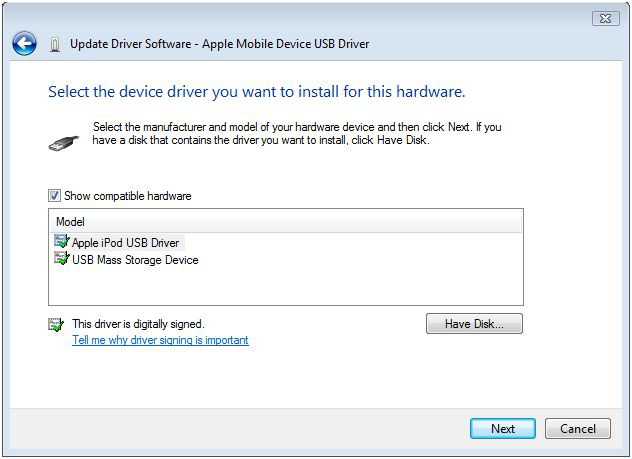
- Click the Browse button and navigate to C:\Program Files\Common Files\Apple\Mobile Device Support\Drivers.
- Double-click the "usbaapl" file. (This file will be called "usbaapl64" if you have a 64-bit version of Windows. If you don't see "usbaapl64" here, or if there is no Drivers folder, look in C:\Program Files (x86)\Common Files\Apple\Mobile Device Support\Drivers instead).
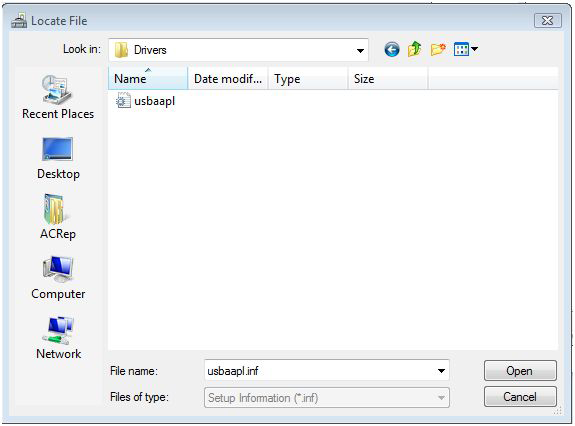
- Click Open in the Have Disk window. Click Next. Then click Finish. Windows will install the driver.
During installation, if a message appears stating that the software you are installing "has not passed Windows Logo testing," click Continue Anyway to continue installing the drivers.
You can find solutions to other common errors and error code numbers in this Microsoft article.
Error Code 52
You might see this message in the Properties window for your device: "Windows cannot verify the digital signature for the drivers required for this device. A recent hardware or software change might have installed a file that is signed incorrectly or damaged, or that might be malicious software from an unknown source. (Code 52)."
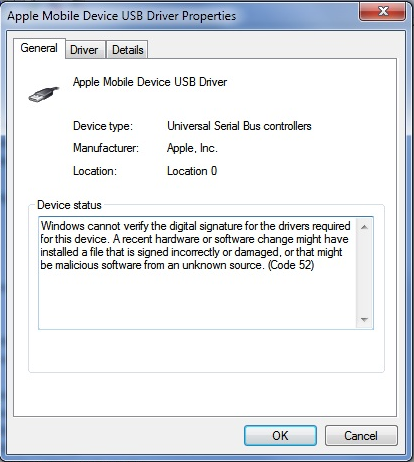
To resolve Error Code 52:
- Install all available updates for Windows. See this Microsoft article for more information on how to do this.
- Consult your computer manufacturer for updates for your computer's drivers, including disk drives, chipsets, and USB controllers.
- Temporarily disable "forced driver signing enforcement" as follows:
- Restart your computer.
- While restarting, press the F8 key.
- Windows Vista and Windows 7:
- The Windows Advanced Options list should appear. Press the Arrow Down key until "Disable forced driver signing enforcement" is highlighted.
- Press the Return key.
- Press the Return key.
- Click "Change defaults or choose other options".
- Click "Choose other options".
- Click "Troubleshoot".
- Click "Advanced options".
- Click "Startup Settings".
- Click "Restart" when prompted.
- When prompted, press the
7
key to "Disable driver signature enforcement".
- Reconnect the device.
If the device is recognized successfully, then you'll need to perform these steps each time you start your computer. Consult Microsoft, or whoever supports the installation of Windows on your computer, for more troubleshooting to resolve the issue without having to select this option each time.
- Disconnect the device from the computer.
- Save a screenshot by pressing the Home button and the Wake/Sleep button at the same time (the screen should flash briefly).
Taking screenshots and saving images on iPod touch requires iOS version 2.0 or later.
- Reconnect the device to the computer.
- Open the Device Manager in Windows:
- Windows Vista or Windows 7:
- Click Start.
- In the dialog, type
devmgmt.msc
.
- Press Return.
- If Windows needs your permission to continue, click "Continue".
- Expand all the sections labeled below (not all sections might be listed):
- Imaging Devices
- Other Devices
- Portable Devices
- Universal Serial Bus Controllers
- Look for the entry that recognizes the device as a camera. This entry should be called Apple iPhone, Apple iPad,
or Apple iPod.
If only "Unknown Device" appears:
- Right-click on the "Unknown Device" entry.
- Choose "Properties" from the shortcut menu.
- Click the Details tab.
- In the drop-down menu, select "Hardware IDs."
- If the hardware ID displayed starts with:
USB\VID_0000&PID_0000
This means that Windows cannot read the hardware IDs of the device, and so has replaced them with all zeros. This is typically caused by a faulty USB connection, or an incompatibility with your USB chipset drivers.
- Disconnect the device, and unplug all USB devices from your computer.
- Shut your computer down, then power it back on.
- Reconnect your device, testing each USB port for approximately 30 seconds to see if your device is recognized.
- Test with an alternate, known-good 30-pin to USB cable or Lightning Connector to USB cable if available.
- If you have an external USB 2.0 hub available, connect the hub to your PC, and then connect the iOS device to the hub.
- If your device shows up in iTunes, try disconnecting the external USB 2.0 hub and connecting the iOS device directly to your PC. If the issue returns, you may need to use the external USB 2.0 hub as a temporary workaround. Then, consult your computer manufacturer for any updates for your USB chipset.
If "Unknown Device" appears when connecting your device to more than 1 known-good computer, with more than 1 known-good USB cable, your device might need service. Learn more about your service options.
Your device might not be recognized while in recovery mode. This can happen during an update or restore of your device. Typically, when your device is in recovery mode, it will show the "Connect to iTunes" logo on its display. If iTunes does not recognize the device when in this state:
Windows Vista or Windows 7:
- Click Start.
- In the dialog, type
devmgmt.msc
.
- Press Return.
- If Windows needs your permission to continue, click "Continue".
- Click the disclosure triangle (
 ) (for Windows 7 and 8) next to Imaging Devices, Other Devices, Portable Devices, and Universal Serial Bus Controllers to expand these sections.
) (for Windows 7 and 8) next to Imaging Devices, Other Devices, Portable Devices, and Universal Serial Bus Controllers to expand these sections.
- Check these sections for one or more entries called Apple Mobile Device (Recovery Mode). These entries might or might not have exclamation marks on them.

Find out if the computer has USB 3.0 ports. Within Universal Serial Bus Controllers, locate any entries containing "USB 3.0" or "SuperSpeed USB" in the title. If these are listed, you have USB 3.0.
- Try to connect the device to a different USB port. Try each port until the device is recognized. Some computers will have dedicated USB 2.0 and 3.0 ports. If so, a USB 2.0 port might resolve the issue.
- Refer to your computer manufacturer for updates to the USB 3.0 chipset drivers.
- If the issue persists, continue to "Check for third-party software conflicts."
- Open the Device Manager and connect your device.
- Click the View menu.
- Select "Devices by connection."
- Locate the erroneous "Apple Mobile Device (Recovery Mode)" entries. You might need to expand all sections of the Device Manager to see them.
- Directly above these entries will be a USB Composite Device entry.
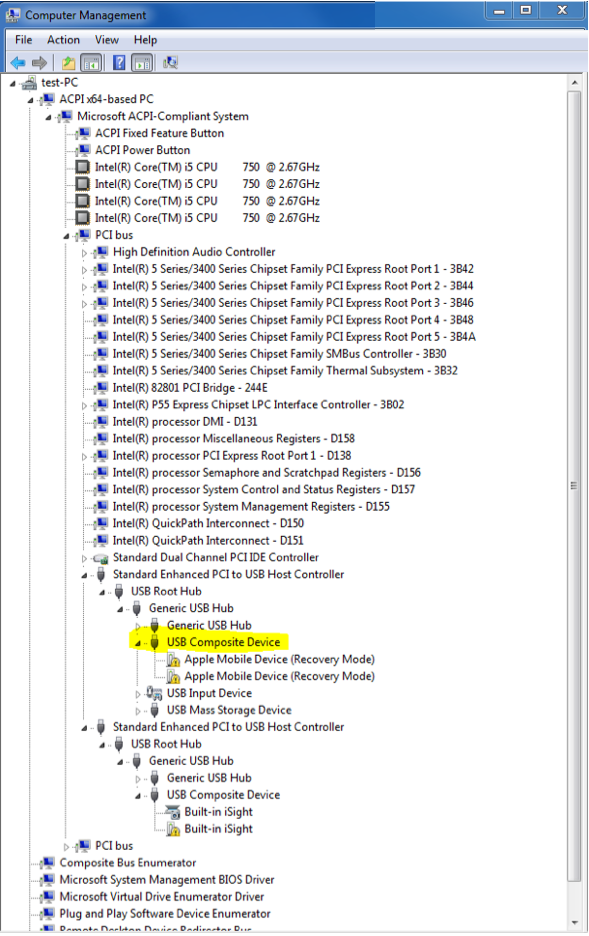
Depending on your version of Windows, take the following steps to update this driver:
Windows Vista, Windows 7, or Windows 8:
- Right-click the parent USB Composite Device entry.
- Choose Update Driver Software from the shortcut menu.
- Click "Browse my computer for driver software".
- Click "Let me pick from a list of device drivers on my computer".
- Click the Have Disk button.
- In the "Install from Disk" dialog, click the Browse button.
- Use this window to navigate to the following folder:
C:\Program Files\Common Files\Apple\Mobile Device Support\Drivers.
- Double-click the "usbaapl" file. (This file will be called "usbaapl64" if you have a 64-bit version of Windows. If you don't see "usbaapl64" here, or if there is no Drivers folder, look in C:\Program Files (x86)\Common Files\Apple\Mobile Device Support\Drivers. instead).
- Click OK in the "Install from Disk" dialog.
- Click Next and finish the driver-installation steps.
- Open iTunes to verify that the device is recognized properly, and continue restoring your device.
Certain phone and cellular device connectivity software from vendors such as Samsung, Nokia, Bora, Novatel, Sony, Android, LG, Sierra, Huawei, Pantech, or Motorola might cause your device not to be recognized. If you have such software on your computer:
- Uninstall the phone or cellular connectivity software temporarily, and test. Contact the manufacturer of this software for assistance in doing this. If you use the third-party phone or cellular device for your Internet connection, try connecting to an alternate network using Wi-Fi or Ethernet.
- Remove iTunes and all related Apple software.
Remove and reinstall iTunes and related software components for Windows Vista, Windows 7, or Windows 8
- After reinstalling iTunes, test the device.
- If you still need your third-party phone or cellular connectivity software that was removed, reinstall this software and test your device to ensure it still functions with iTunes. Contact the vendor of your phone connectivity software if the issue returns.
Also, third-party security software might conflict with iOS devices connecting to iTunes. Follow this article to troubleshoot issues that might be caused by your security software. After resolving any issues that you might have with your security software, you might need to try the steps in this article again.
I hope this information helps ....
- Judy










